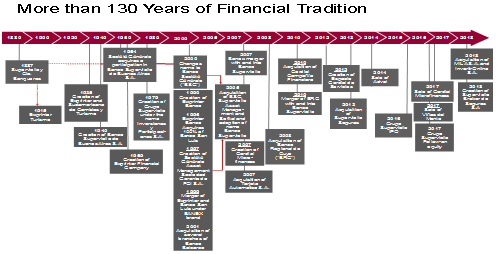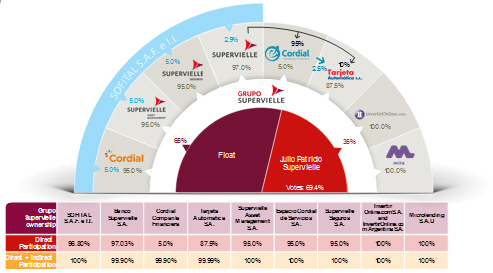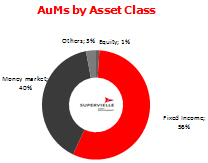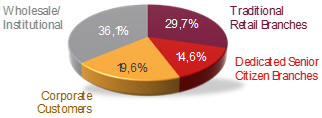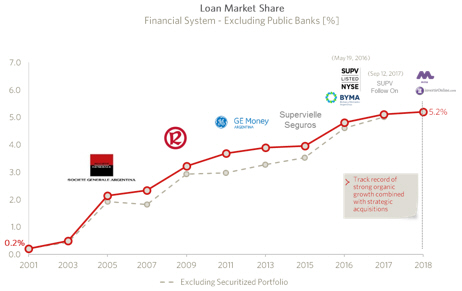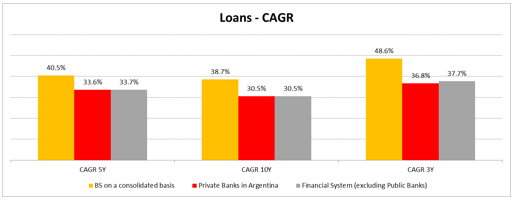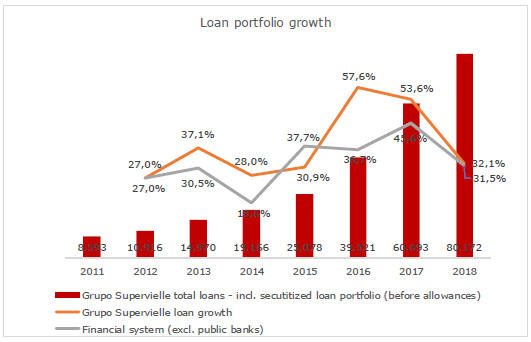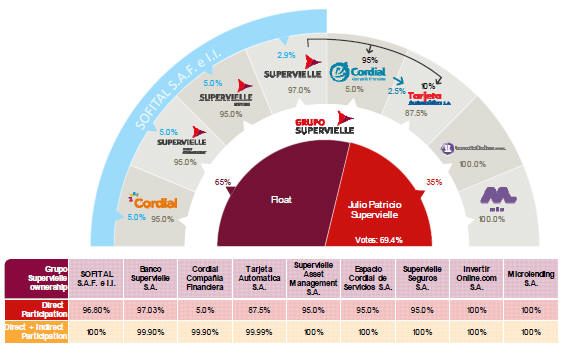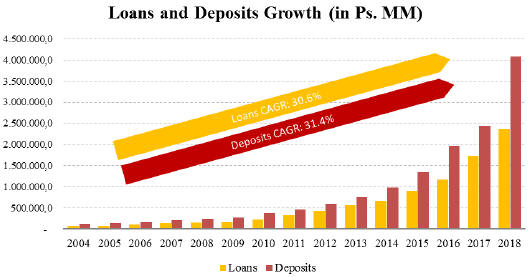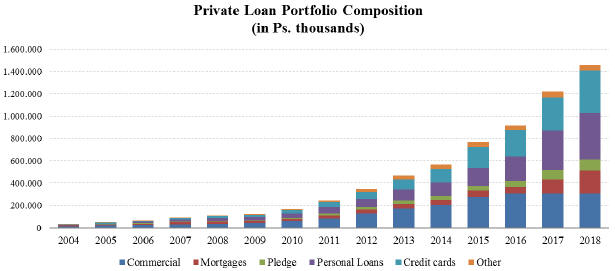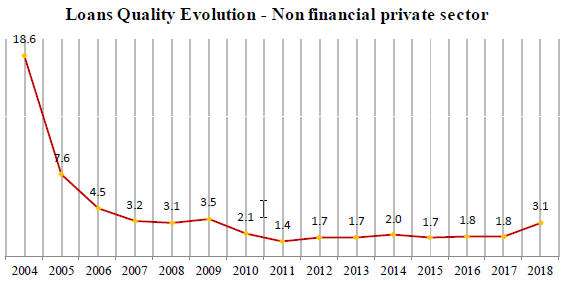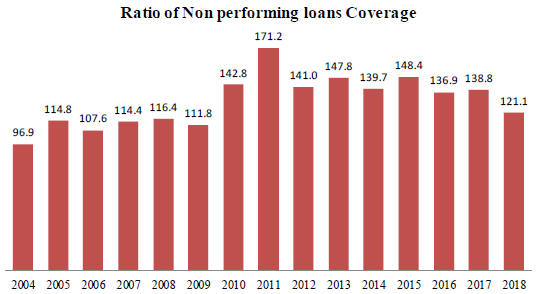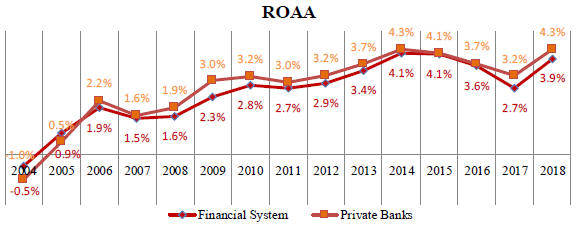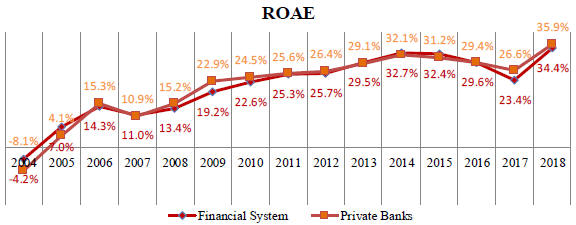Because the Class B shares are not themselves listed on a U.S. exchange, dividends
received with respect to the Class B shares that are not represented by ADSs generally will not be treated as qualified dividends. U.S. holders of Class B shares or ADSs should consult their own tax advisors regarding the availability of
the reduced dividend tax rate in the light of their own particular circumstances.
Dividends received by U.S. holders will generally
constitute foreign source and “passive category” income for U.S. foreign tax credit purposes. Subject to limitations under U.S. federal income tax law concerning credits or deductions for foreign taxes, any Argentine taxes withheld from
cash dividends on the Class B shares or ADSs will be treated as a foreign income tax eligible for credit against a U.S. holder’s U.S. federal income tax liability if the tax is treated for U.S. federal income tax purposes as imposed on the
U.S. holder (or at a U.S. holder’s election, may be deducted in computing taxable income if the U.S. holder has elected to deduct all foreign income taxes for the taxable year). However, amounts withheld on account of the Argentine personal
assets tax (as discussed in “—Material Argentine Tax Considerations”) will not be a foreign income tax eligible for credit against a U.S. holder’s U.S. federal income tax liability. The rules with respect to foreign tax
credits are complex and U.S. holders are urged to consult their independent tax advisors regarding the availability of the foreign tax credit under their particular circumstances.
Passive Foreign Investment Company
Based on the past and projected composition of our income and assets, and the valuation of our assets, including goodwill, we do not believe we
were a PFIC for our most recent taxable year, and we do not expect to become a PFIC in the current taxable year or in the foreseeable future, although there can be no assurance in this regard.
In general, we will be a PFIC for any taxable year in which:
| |
• |
|
at least 75% of our gross income is passive income, or |
| |
• |
|
at least 50% of the value (determined based on a quarterly average of our assets is attributable to assets
that produce or at held for the production of passive income. |
For this purpose, passive income generally includes
dividends, interest, royalties and rents (other than royalties and rents derived in the active conduct of a trade or business and not derived from a related person). If we own at least 25% (by value) of the stock of another corporation, for purposes
of determining whether we are a PFIC, we will be treated as owning our proportionate share of the other corporation’s assets and receiving our proportionate share of the other corporation’s income.
Our determination with respect to our PFIC status is based in part upon certain proposed U.S. Treasury regulations that are not yet in effect
and which are subject to change in the future. Those regulations and other administrative pronouncements from the IRS provide special rules for determining the character of income derived in the active conduct of a banking business for purposes of
the PFIC rules. Although we believe we have adopted a reasonable interpretation of the regulations and administrative pronouncements, there can be no assurance that the IRS will follow the same interpretation.
The determination of whether we are a PFIC is made annually. Because we have valued our goodwill based on the market value of our Class B
shares and ADSs, a decrease in the price of our Class B shares and ADSs may also result in us becoming a PFIC. Accordingly, it is possible that we may become a PFIC in the current or any future taxable year due to changes in our asset or income
composition. If we are a PFIC for any taxable year during which you hold our Class B shares or ADSs, you will be subject to special tax rules discussed below.
If we are a PFIC for any taxable year during which you hold our Class B shares or ADSs and you do not make a timely mark-to-market election, as described below, you will be subject to special tax rules with respect to any “excess distribution” received and any gain realized from a
sale or other disposition, including a pledge, of such Class B shares or ADSs. Distributions received in a taxable year will be treated as excess distributions to the extent that they are greater than 125% of the average annual distributions
received during the shorter of the three preceding taxable years or your holding period for the Class B shares or ADSs. Under these special tax rules:
| |
• |
|
the excess distribution will be allocated ratably over your holding period for the Class B shares or
ADSs, |
| |
• |
|
the amount allocated to the current taxable year, and any taxable year prior to the first taxable year in
which we were a PFIC, will be treated as ordinary income, and |
| |
• |
|
the amount allocated to each other year will be subject to tax at the highest tax rate in effect for that year
and the interest charge generally applicable to underpayments of tax will be imposed on the resulting tax attributable to each such year. |
Although the determination of whether we are a PFIC is made annually, if we are a PFIC for any taxable year in which you hold
our Class B shares or ADSs, you will generally be subject to the special tax rules described above for that year and for each subsequent year in which you hold Class B shares or ADSs (even if we do not qualify as a PFIC in such subsequent
years). However, if you own Class B shares or ADSs and we cease to be a PFIC, you may be able to avoid the continuing impact of the PFIC rules by making a special election to recognize gain as if your Class B shares or ADSs had been sold
on the last day of the last taxable year during which we were a PFIC. You are urged to consult your own tax advisor about this election.
In lieu of being subject to the special tax rules discussed above, you may make a mark-to-market election with respect to your Class B shares or ADSs provided such Class B shares or ADSs are treated as “marketable stock.” Class B shares or ADSs generally will be
treated as marketable stock if the Class B shares or ADSs shares are regularly traded on a “qualified exchange or other market” (within the meaning of the applicable Treasury regulations). Under current law, the mark-to-market election may be available to holders of ADSs for as long as the ADSs are traded on the NYSE, which constitutes a qualified exchange, although there can be no
assurance that the ADSs will be “regularly traded” for purposes of the mark-to-market election. The Class B shares are traded on the ByMA, which must meet
certain trading, listing, financial disclosure and other requirements to be treated as a qualified exchange for these purposes, and no assurance can be given that the Class B shares will be “regularly traded” for purposes of the mark-to-market election.
If you make an effective mark-to-market election, for each taxable year that we are a PFIC you will include as ordinary income the excess of the fair market value of your Class B shares or ADSs
at the end of the year over your adjusted tax basis in the Class B shares or ADSs. You will be entitled to deduct as an ordinary loss in each such year the excess of your adjusted tax basis in the Class B shares or ADSs over their fair
market value at the end of the year, but only to the extent of the net amount previously included in income as a result of the mark-to-market election.
Your adjusted tax basis in the Class B shares or ADSs will be increased by the amount of any income inclusion and decreased by the amount of any deductions under the
mark-to-market rules. In addition, upon the sale or other disposition of your Class B shares or ADSs in a year that we are a PFIC, any gain will be treated as
ordinary income and any loss will be treated as ordinary loss, but only to the extent of the net amount of previously included income as a result of the mark-to-market
election.
If you make a mark-to-market election, it will
be effective for the taxable year for which the election is made and all subsequent taxable years unless the Class B shares or ADSs are no longer regularly traded on a qualified exchange or other market, or the IRS consents to the revocation of
the election. You are urged to consult your tax advisor about the availability of the mark-to-market election, and whether making the election would be advisable in your
particular circumstances.
Alternatively, holders of shares in a PFIC can sometimes avoid the special tax rules described above by
electing to treat the PFIC as a “qualified electing fund” under Section 1295 of the Code. However, this option is not available to you because we do not intend to comply with the requirements necessary to permit you to make this
election.
If we are a PFIC for any taxable year during which you hold our Class B shares or ADSs and any of our non-U.S. subsidiaries is also a PFIC, you will be treated as owning a proportionate amount (by value) of the shares of the lower-tier PFIC for purposes of the application of the PFIC rules. You are urged to consult
your tax advisors about the application of the PFIC rules to any of our subsidiaries.
You will generally be required to file IRS Form
8621 if you hold our Class B shares or ADSs in any year in which we are classified as a PFIC. You are urged to consult your tax advisors concerning the U.S. federal income tax consequences of holding our Class B shares or ADSs if we are
considered a PFIC in any taxable year.
Sale or Other Disposition
Upon a sale or other disposition of the Class B shares or ADSs, U.S. holders will recognize gain or loss for U.S. federal income tax
purposes in an amount equal to the difference between the U.S. dollar value of the amount realized on the disposition and the U.S. holder’s tax basis, determined in U.S. dollars, in the Class B shares or ADSs. Subject to the discussion
under “—Passive Foreign Investment Company” above, such gain or loss will generally be capital gain or loss, and will be long-term capital gain or loss if the Class B shares or ADSs were
held for more than one year. A U.S. holder’s ability to offset capital losses against ordinary income is limited. Long-term capital gain recognized by an individual U.S. holder may be taxable at a
preferential rate. If an Argentine tax is withheld on the sale or other disposition of the Class B shares or ADSs, a U.S. holder’s amount realized will include the gross amount of the proceeds of the sale or other disposition before
deduction of the Argentine tax. See “—Material Argentine Tax Considerations—Capital gains” for a description of when a disposition may be subject to taxation by Argentina. This gain or loss will generally be
U.S.–source gain or loss for foreign tax credit purposes. U.S. holders should consult their tax advisors as to whether the Argentine tax on gains may be creditable against the U.S. holder’s U.S. federal income tax on foreign-source income
from other sources.
Foreign Financial Asset Reporting
Certain U.S. holders that own “specified foreign financial assets” with an aggregate value in excess of U.S.$50,000 are generally
required to file an information statement along with their tax returns, currently on Form 8938, with respect to such assets. “Specified foreign financial assets” include any financial accounts held at a
non-U.S. financial institution, as well as securities issued by a non-U.S. issuer (which would include the Class B shares and ADSs) that are not held in accounts
maintained by financial institutions. Higher reporting thresholds apply to certain individuals living abroad and to certain married individuals. Regulations extend this reporting requirement to certain entities that are treated as formed or availed
of to hold direct or indirect interests in specified foreign financial assets based on certain objective criteria. U.S. holders that fail to report the required information could be subject to substantial penalties. In addition, the statute of
limitations for assessment of tax would be suspended, in whole or part. Prospective investors should consult their own tax advisors concerning the application of these rules to their investment in the Class B shares and ADSs, including the
application of the rules to their particular circumstances.
Information Reporting and Backup Withholding
Dividends paid on and proceeds from the sale or other disposition of the Class B shares or ADSs that are made within the United States or
through certain U.S.-related financial intermediaries generally will be subject to information reporting unless a U.S. holder is treated as an exempt recipient and may also be subject to backup withholding unless a U.S. holder (i) provides a
correct taxpayer identification number and certifies that it is not subject to backup withholding or (ii) otherwise establishes an exemption from backup withholding. Backup withholding is not an additional tax. Any amounts withheld may be
allowed as a refund or credit against the holder’s U.S. federal income tax liability, provided the holder timely furnishes the required information to the IRS.
268
